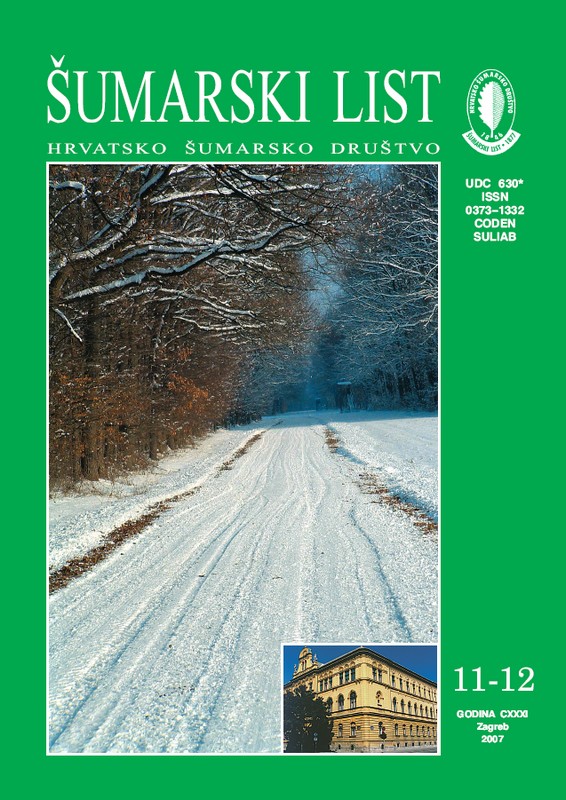
broj: 11-12/2007
pdf (28,4 MB) |
|
||||||||||||||
| IZVORNI ZNANSTVENI ČLANCI | ||
| Pernar, R., M. Ančić, A. Seletković | UDK 630* 429 + 453 (001) | |
| Application of Colour Infrared Aerial Photographs for the Assessment of Forest Damage in the Gospić Forest Administration pdf HR EN | 507 | |
| Kajba, D., N. Pavičić, S. Bogdan, I. Katičić | UDK 630* 165 (001) | |
| Pomotechnical Treatments in the Broadleave Clonal Seed Orchards pdf HR EN | 523 | |
| Ivanković, M. | UDK 630* 165 (001) | |
| Posibility of Genetical Introgresion of Nordmann fir (Abies nordmaniana /Steven/ Spach) in Common Fir Forests (Abies alba Mill.) of Macelj and Trakošćan pdf HR EN | 529 | |
| PREGLEDNI ČLANCI | ||
| Margaletić, J., V. Jurjević, M. Glavaš, B. Hrašovec, D. Diminić | UDK 630* 453 | |
| The Analises Extermination of Gypsy Moth (Lymantria dispar L.) in the 2005 Year of Croatian State Forests pdf HR EN | 539 | |
| Dasović, M. | UDK 630* 907.1 + 907.2 : 652 | |
| Biological-Ekological and Spatial Evaluation of “Laudonov Gaj” Park Forest PDF | 549 | |
| STRUČNI ČLANCI | ||
| Nikolandić, Đ., D. Degmečić | UDK 630* 156 | |
| Recruitment Rate of the Roe Deer (Capreolus capreolus L.) in Baranja Forests pdf HR EN | 565 | |
| Summary: By means of the total count method, the basic population of roe deer on three separate and ecologically different roe deer habitats was counted this March and analysed according to gender/age. Based on the number of kids found during the counting procedure, and after culling and recording the loss of kids during the period from October – March, recruitment rate of roe deer kids for the last hunting year was determined. The determined number of roe deer kids and adult (brood) does was used to calculate the coefficient of recruitment rate of the roe deer kids in the last hunting year. The accuracy of the coefficient determined in such a way is questionable, and the usage of that coefficient in planning the recruitment rate for making hunting plans is not to be recommended. The long-term experience in the breeding of roe deer and this research have proven that determining the recruitment rate of roe deer kids in the above mentioned way, does not provide us with accurate data because of the following reasons: – counting the roe deer in March does not provide us with accurate details on the number of roe deer kids, because on greater distances and with the fast movement of the game it is difficult to see the difference between a doe and a kid, since roe deer kids are very similar to adult does in March: they have similar bodily constitution and winter fur. – the recorded loss of kids during autumn-winter period cannot be considered complete, because we cannot determine the real number of dead roe deer kids just by the number of corpses or parts of the skeleton found, – the real number of roe deer kids lost in poaching and in traffic accidents cannot be determined based only on the number of recorded cases of poaching; – in greater distances and during movement of roe deer it often cannot be differentiated between genders of the roe deer kids and therefore the number of female kids which will be counted into the female part of the base fund of roe deer population in the new hunting year, cannot be accurately determined. If we do not know the exact number of female kids, than we cannot know how many two year old there will be, i.e. roe deer does which will not have young this year, but the next. Tracking the growth of recruitment rate of roe deer from fawning season (May – June) till the beginning of hunting season (October), observing and searching the fawning territory before mowing of the clover-patches and meadows is useful for prevention of game damage and for recording of the causes of loss of newborn fawns (rainy and cold weather, predators, etc.). Finally, for the above mentioned reasons, we believe that only the process of recording the number of roe deer kids in autumn, before the hunting season (September, October) can give us accurate data on the real recruitment rate based on which we can make corrections in the recruitment rate of roe deer kids and the changes in the scope and structure of the yearly culling plan. Key words: Baranja; embryo; fertility; mortality; number of adult roe deer does; number of kids; planned recruitment rate; real recruitment rate | ||


